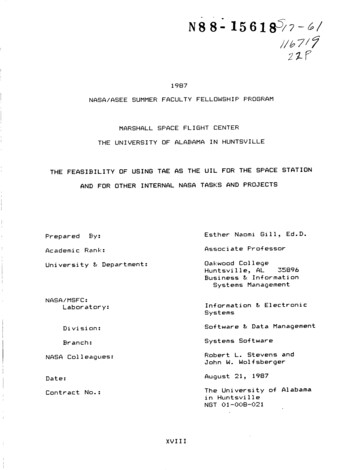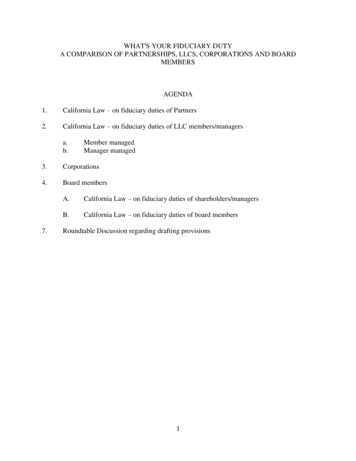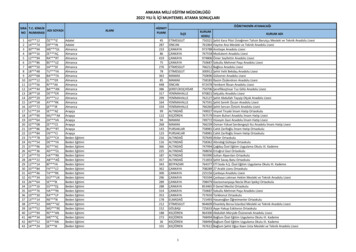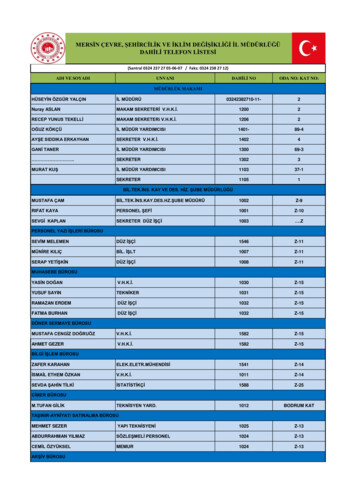
Transcription
N8 8-15618 ?- /il versityin 01-008-0211987ofAlabama
2.0ACKNOWLEDGEMENTSMythanksgo againto theInformationand ElectronicSystemsLaboratory,W.C. ;SystemsSoftwareBranch,WalterMitchell,Chief;and colleaguesRobertL.Stevensand JohnW. ,sharedtheirfacilities,and gaveof theirexpertiseand timewhichprovidedthenecessaryatmosphereand pleasantsurroundingsforthisresearcheffort.Earlyin thesummer,CathyWhitesharedherlibraryof currentTAEhappenings,andBob Stevensbriefedme ontheareaofresearchI wasto addressfor whichI am grateful.TerryBrownmadesurethatthe partitionswereremovedfromtheharddiskofmy computerwhichpermittedme to gainaccessand onsofenteringtextand not beingableto saveit.To JohnWolfsberget whoinvitedElfriedaHarrisfromtheTAE SupportOffice,andco-editorof ,MD20771to conductaTAEworkshopfortheSystemsSoftwareBranchand me,in particular,on my topic--I'mgrateful.KayeLangfordand BrendaSparksaidedingettingmy viewgraphstogetherfor my andthecooperationof tile.Last,butnotleast,highestpraisegoesto ASEE,the designersoftheSummerFacultyFellowshipProgram;The UniversityofAlabama,Huntsville,sponsors,Dr. GeraldR. r. Karr'ssecretary,foryouruntiringeffortsin keepingus informedofprogramhappeningsand for alwaysbeingavailableto answerquestionsand stantfor sharingin theimplementationof the VIII-i
THE FEASIBILITY OF USING TAE AS THE UIL FOR THESPACE STATION AND FOR OTHER INTERNAL NASA TASKS AND PROJECTSByEsther Naomi Gill,Ed.D.AssociatePPofessor of Computer ScienceOakwood CollegeHuntsville,AL358963.0ABSTRACTThis descriptionof TransportableApplicationsExecutive(TAE) isintendedto serve as a determinationof thefeasibilityof its use as the Space StationUserInterfaceLanguage(SSUIL).TAE was developed by the Space Data and ComputingDivision,Space and Earth Sciences Directorateof the NASA/GSFC(Goddard Space FlightCenter) and by Century Computing,Inc. in1980.TAE is an executiveprogram that tiesa systemof applicationprograms into a singleeasilyoperated whole & supportsusers'operationsof programs througha ace.TAE alsosuppliestheinterfacebetween the user and the variousapplicationprogramsin a particularcomputer system.It appears to be an effectiveuser interfacefor infrequentas well as for expert users.The UIL willsupport softwaredevelopment,on board and onground operations,tests & diagnoses,and a familyof languages(Ada, Assembly, BASIC, C, COBOL, FORTRAN, Pascal).Prospectiveusers of the SSUIL are Requirementand SpecificationEngineers,Coding and TestingEngineers;ExperimentersSoftware Designersand DevelopersMaintenance Engineers,and Crewpersons.For most applications,the variouselements of thesystemare so complex that users cannot communicate directlywiththeoperationalprograms, but must manage the system throughintermediate interfaces.An applicationsexecutiveis a master program which unifiesthe many subprograms of the system.TAE useseveryday terminology,is almost100 percentmachine independent,isNASA owned imposes no restrictionsonthetype of applicationprograms supportingTAE, permitstheprototypingof systems withoutwritingany code, and can interface with FORTRAN C, and Ada programming applications.TAE isprimarilya text-baseduser interfacemanagementsystem utilizingprograms that acquireparametersor a commandlanguage which is not appropriatefor all SS applicationsneeding solutions.TAE is neitherinuse for real-timeoperationsnor integrationand tests which are primaryUI functions.Nevertheless,since there are more pros than cons for theuse ofTAE as the UIL for the SS and other NASA internaltasksand pro3ects,I say, why not give it a try with nothingto loseand possiblyeverythingto gain, as it is alreadya NASA owned/maintainedinterfacingprogramming tool.XVIII-ii
gCommandParameters6 . .2.1Procs6. .Parameters2.69ModeLANGUAGE5.Mode. 1618
lityguage(UIL)of theTAE is intendedto serveas a determinationofusingTAEfor the UserInterfaceLanSpaceStation(SS).Thistreatusis not anexhaustiveexaminationof TAE'scapabilities;can be foundin theReferencesectionof thisdetailsdocument.onTAEThe TransportableApplicationsExecutive(TAE)was developedbythe SpaceDataand ComputingDivision,Spaceand EarthSciencesDirectorate,of the cationsa utiveprogramthattiesaapplicationprogramsinto a singleeasilyoperatedsupportsusersoperationsof interface.developedto betterservethe needsof the end user,cationprogrammer,and the systemsdesigner.systemofwholeandconsistentItwasthe appli-TAE alsosuppliestheinterfacebetweenthe variousapplicationprogramsina particularcomputersystemand theuser.TAEcommunicateswiththe nd on-linehelp.It appearsto be an effectivewellasfor faceto application5.2userinterfaceforinfrequentasis highlyportable(87% of code),and manentlymannedSpaceStationcallsfor one of the mostdemandingarraysof softwarecapabilitiesthatany projecttodatehas beenrequiredto ein the productionof customizedsoftware;andit finallyrecommendedthatonelanguagebe designatedfor theproductionof dawas recommended.MSFChas missionresponsibilitytoproducethesoftwareto be gesprovidedby otherworkpackages,theMSFCsoftwaremanageris developingplansto integrateand testXVIII-1
softwareprovidedby other centers.Thisas wellas thosedevelopedby MSFC willrequireMSFC developed softwaretobeintegratedinto a totalSpace Stationpackage at the same timesoftwarepackagesfromothersourcesmust be matedandintegratedinto the MSFC packages for subsequentverificationof the totalSpace Stationsystem.The UIL erations,tests and diagnostics,and a familyoflanguages(Ada Assembly, COBOL9 FORTRAN, BASIC, Forth Pascal,C etc.).Itshouldbe device independentand transparent(friendly)to the user.The prospectiveLanguage (SSUIL)usersof the Spaceare icationEngineersSoftware Designers and DevelopersCoding and Testing Crewpersons(Astronauts,Scientists,Flightand Ground Controllers,Payload Operators,and ApplicationCustomers)The userswillbe utilizingStation(SS) operationsas:theUIL tosupportsuch- Planningand Scheduling- Interactingwith Real-timeModular/PayloadSatellites- ntrolling& MonitoringSpace- EnvironmentControland Life-SupportSystems(ECLSS)- Communicatingwith other Languages- Detectingand DiagnosingEquipment Malfunctions- Interactingwith ConfigurationManagementMalfunctions- MonitoringOn-Going Systems and Making Adjustmentsor Troubleshootingwhere Needed- Examining and Updating Databases- Monitoringand Recording Observations- Interactingand Communicating with Ground Systems,Interpreting,Recording,and Presentingof data- Communicatingwith Payloads- ForecastingPotentialConditionsand Making Contingency Analyses- ValidatingSystems PerformanceXVIII-2Space
- Creatingand DescribingGraphics- EvaluatingProgram'sPerformance- MonitoringUsers' Use of UILDisplaysOn an interactivecomputer system, the usergivesdirectionsfor themachine'soperation For most applications,the variouselements of the system are so complex thatuserscannotcommunicatedirectlywiththe operationalprograms butmustmanage the system through an intermediateinterface An applicationsexecutiveis a master program which unifiesthemany subprogramsofthesystem.In generalan executiveshould facilitatethe user'sinteractionwith the computer by:i grams.Shieldingthe userfromthe hostoperatingsystem.Providinga congenialenvironment.XVIII-3
6.0TAEFEATURESTAEconsistsof .mProcs(processesorrefersto ialof icesofthesystemfeatureandadaptit foratothevariousinteractively--totopicorin 1associatedTableFUNCTIONthemethodsof resourceskindsofaidyou,useof theModelbuilda ilableeitheronanindividualsystemas a entsaccommodateindividualexperiencewith
OperationalProcs&ParametersA collectionof tivitiesnecessarytocompleterequiredtasks.HelpA meansof supplyingbothsupplementalinformationon asingletopicand asystematicteachingtoolfor thenew RAMETERSThe userseesTAE as an interfacehavingtwomodes:menuandcommand Noviceorcasualusersmaketheirway throughthesystemby meansof menusaugmentedby extensiveon-linehelp.Experiencedusershavea powerfullanguagefor commandingthesystemandcontrollingthe nationsof the system In eithermodethe user'sultimatepurposeis the same:to executethe applicationfunctionsof the system.6.2.1ModesWithmodes:TAEI nddirectionsMenuModewhereyounumberedlist presentedCommandthroughtotheselecton thecomputerModewhereyoucommunicatewiththe TAE CommandLanguage(TCL).selecteddependsonwiththe featuresin usingTAE.theof1.fourtypesContents:you needC- -thetotheknowscreentasktobethe systemshowsinstructions,at qMenuMode--InMenuModeTAEtheuserby meansof fourtypesof displays:Tutor(3) Help,and(4) wokindsorandone'swith(2)ofdata
fthe1 forTAEmenu(2)Tutor:Oncea userreachesa proc,heor sheis"tutored"to enterthedesiredparametervalues.In a tutorsessionthetiberseesa screencontaininga luescanbechangedeasilythroughthetutorsession.Witha urerestoration.Figure2showsayouareusinga triesonthescreen)andmenuEom enuIllustrationwhichfollowsaOn elowerto make:youlogonasa menuusermenuquestionmark(?)left-sideof tivemustbeself-contained.Thatisit structionsfortheiruse.TAEprovidestheuserwithhelpin fivecategories:a procoraTAEcommanda menutheoperationofa modetheparametersofa procanda TAEmessage.AtypicalTAEwhichcontainsly lpoptionsscreen).A ormationin thetoppartof(arrangeddisplayistoa )acrossthetoreportanerrororconsistsofasingle
I.LI.l.0W -.1owZWW5I--ZZ I.UDI.LIa::0 rrlZl--I---rr .NzWz .u-u.,-2za.FIGUREXVIII-71
00tCObOHt2HXrHCIWm0 HooI/IllW1,4HcO0o0U}umt O. .iE0WI-iErrgrr-I.1-1I11E2r-t.,-4,0m,00r0,.-I.xII I,.igpl .i IU00OHrXVIII-8
dby additionalhelp,whichabytyping" ? " whenthemessageoccurs.TAE,Anyuser6.2.1.2Usinq ommand s,whohavea at rocorto ameofkeyboard.inIn aprocCom-aataIn addition,anytime.Usersmayalsosetup ures-collectionsofTAEcommands,executedasa callyfoundina dpreviousIn a useroperatesThereisa commandcommandin ds.procthrougha classiccommandin eature.Utility(1)ApplicationprocsusuallyA
6.2.2.2Parameters:Once you invoke the proc you want,youmay adapt it to your own use.Each proc has a parameter or setofparameterswhichmay be given differentvalueswhen theprogram is run for a specificreason.DefaultedParameters--Inmany cases,a parameter willhave apredefinedvalue(basedon what is most convenientormostcommonly used).Thisvalue isthe"default;"if you do notreplaceit with another value,the programexecutes using thisvalue.Whetheryou are working in Menu Mode orinCommandMode, you willhave the optionof enteringparameter dataoracceptinga defaultvalue before activatingthe proc.6.3HELP (INFORMATIONAL/INSTRUCTIONAL)Unlike some systems,help instructionsfor TAE willnot appearof theirown accord when the computer detectsthat the operatorismaking mistakes atthe terminal.You must request help-on-linehelp is availableat all times during your TAE sessions.Help is availablein severaldifferentwhatmode you arein,thesystemassistanceon almost any item.6.4formscanon TAE.provideNo matteryou withTCL (TAE COMMANDLANGUAGE)The TAE command language (TCL) is a classiccommand languagebased on Digital'sDCL, the IBM System/38 command language,theUNIX shelland C shell,and the deliberationsof theANSIcommitteestandardizingOperatingSystem Command and ResponseLanguages.A TCL command line consistsof the nameintrinsiccommand, followedby commandvalues.Parametervaluesfor any proccommands aregivenby theuser eitherassociatingthe value with the name of theof a proc ora TCLor procparameterand most intrinsicpositionallyorbyparameter.As an example,assume we have a proc named DOIT,withtwointegerparametersnamed A and B, and a stringparameter namedC.Assume furtherthat the PDF for DOIT specifiesthattheorderofthe parametersis A, B, C.One may specifytheinitialvalue of the proc in any of the followingways:DOIT I, 4, helloDOIT I, C hello,B 4DOIT C hello,A I, B 4XVIII-IO
Command linesmay be continuedpast the end ofthephysicalterminalline;the number of continuationsdepends on the hostfacility.Comments may be appended toany command line,includingcontinuedcommand lines.If the definitionof a parameterspecifiesa defaultvalueandtheuser gives no value for the parameteron the command line,thenthedefaultvalue willbe assumed.If the PDF didnotspecifya defaultvalue,then the TAE command lineinterpreterwillrespondwitha messageindicatingtotheuserwhichparametersrequireIn ingallterminalobtainhelpinformationona TAEona ingtoTCLofvariables;I/O;intrinsica menu,saveorrestorea setofTCLvariables;initiatea d-typearithmeticoperations.Avalueisassignedto a ndmultiplicationarithmeticoperators,a NOT,AND,andOR.Tosavetheglobalvariablestoa fileusetheTCLSAVEcommand.XVIII-11
7.0The1 iveownedby onsitis keywords.m.of letointerfacewithFORTRAN,C, s.XVIII-12
lexibilityand 4.TAElowerscostof softwaredevelopmentthrusavingsin developmenteffortsreducedmaintenanceoverhead,and decreasedupgradetime.15.TAE facilitatesbuildinga systemfordevelopingand customizing,in any discipline,and convenientXVIII-13by supplyingtoolsinteractiveanalysisimplementation.
8.0ThedisadvantageStation(SS)Useri forusingTAEInterfaceLanguageTAEgraphicsis marilymanagementparametersappropriatetions. auserssessions amsora thoutsomefunction4uCONSTAEonaddeda dfromisneitherin I-14
9.0SUMMARY, CONCLUSIONSAND RECOMMENDATIONSMany computeractivitiesuse multipleprograms toperformatask.For some applications,these programs are numerous, complex,and interrelated.Thus the user needs help inmanagingthe variousoperations.The TAE executiveand the programssystem providesin a particularan interfacebetweencomputer application.theuserAs a system,TAE contains3 2) Managerial,and (3) ovidesexplanationandtrainingon the system through the HELP component. The Managerialdomainallowsthe user to givedirectionsto thesystemthrough the MENU and COMMANDMODE components.The Operationaldomainsuppliesthe analyticaland servicefeaturesofthesystem through the PROC and PARAMETERcomponent.At the leastI see TAE as a prototypingdesignersfor the variousSpace Stationother internalNASA projectsand tasks.tool to be utilizedoperationsas wellbyasAtthemost,I see program designersusing TAE todevelopexpertsystems that join togethervariousnew and previouslywrittenand maintainedprograms which in turn willbe utilizedby users (of both advanced and novice types)to get answerstoquestions,tosupply data,to controland monitoron-goingsystems and operations,to make adjustmentswhere needed tomaintain,interactand communicatewithGround Systemstoexamineperformancesand todetect,diagnose,and correctmalfunctions,to communicate with other programming languages,etc.mentioningonly some of the operationsthat need tobeperformedon the Space Station.In order forsuccessfully,nessdetailsorall of these and more operationsto bethe designerswillneed to buildusersimplicityas possibleofuseintotransparentthesystemto herNASA
arch31, erforthe TransportableApplication1.0)"by PatriciaA.Carlson,CarmenAnaL. Harris,and DorothyC. West(VersionElfriedaBrochureTAEwas developedby the SpaceDivision,Space& EarthSciencesDirectorateGreenbelt,MD 20771,and by CenturyComputing,Street,Laurel,MD 20707."Release(VersionComputingNotesfor or the ftwareWolfsberger,SSE and TMISto be publishedin an , 1987."TAENewsRelease--August,1987,"byAlbertE. Hornand MorrisC.Harwell,SeniorSystemAnalystsfor ntsville,AL 35802,NASAContractorsfor the uccessfullyimplementedand testedtwomethodsto interfaceDEC VAX Ada applicationswithTAE.For moredetails,callAlor Morrisat AC 205 - 533-3822if youareacan't-wait-to-tryTAE/Adauserand/orreadyour October,1987,issueof TAE News."TAETutorial,"ConductedJuly28,and 29,1987 at NASA/MSFC,Information& entDivision,SystemsSoftwareBranchby Mrs.ElfriedaLHarris,Co-editor,TAE Newsletter,publishedtri-annually(February,June& October)--theNewslettercontainsupdateson TAEXVIII-16
users--TAEAnalysisisfreeNewsFacility,to ytheTAENASA/GSFCReference(VersionMarch(UIP)Plan ber82-
11.OLISTOFACRONYMSASEEAmericanBASICBeginnersCA tyAll nSymbolicInstructionB SystemFile
THE FEASIBILITY OF USING TAE AS THE UIL FOR THE SPACESTATION AND FOR OTHER INTERNAL NASA TASKS AND PROJECTS By Esther Naomi Gill, Ed.D. Associate PPofessor of Computer Science Oakwood College Huntsville, AL 35896 3.0 ABSTRACT This description of Transportable Applications Executive (TAE) is intended to serve as a determination of the feasi-


